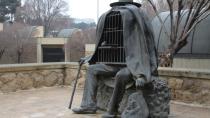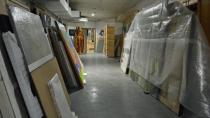The art of diplomacy: Getting Warhol and Picasso out of Tehran
Less than a year after the landmark nuclear deal came into effect, Iran was on the verge of another unlikely diplomatic breakthrough.
But these lesser-known Iran talks have led nowhere. And one of the country's most powerful arsenals remains locked away deep in the bowels of a dimly lit state-owned building in Tehran, hidden from the world's eyes.
Some might call that a tragedy.
Because by any measure, the collection held at the Tehran Museum of Contemporary Art is exceptional, the greatest outside the West.
Warhol and Picasso, Renoir and Degas, Bacon and Monet form the cornerstones of a collection featuring some 1,500 precious modern art pieces that have been absent from the wider art world for more than four decades.
Some of the pieces, like Warhol's Portraits of Mao and Picasso's The Painter and his Model, are widely recognized. Others, like Jesus Rafael Soto's Canada, are less so.
American Jackson Pollock's Mural on Indian Red Ground is the most valuable, estimated by the Tehran museum at $400 million US.
And yet all the works have mostly been sitting in the museum's vault for more than a generation, hostages of circumstance and kept far from the places where they were created.
It has been a challenge to even show the pieces in Tehran.
The country's Islamic revolution meant the collection fell out of favour — and was best kept out of view — with a leadership that eschews anything Western.
And because of conservative Islamic law, putting some of the pieces on display would be the artistic equivalent of publicly reading Lolita in Tehran.
But at a time when Iran is opening up to international investment and tourism following the nuclear deal with world powers, the collection could easily be a mighty instrument of soft power abroad.
That such an instrument has never been fully deployed is not for lack of trying.
'We had to cancel the contract'
In what would have been a fine display of art diplomacy, 30 of the pieces were set to travel to Berlin late last year, then on to Rome, for the first major exhibition from the collection in a Western capital. The shows, which would have also included 30 of the 1,500 or so Iranian pieces held in the same vault, had been in the works since 2015.
"This was the first time we wanted to send so many pieces from our own vault to another country," said Hassan Noferesti, who speaks for the museum.
But after extensive negotiations to set the terms, the initial December start date came and went. A later date was set. But still nothing.
"Everything was finally solved except the export licence," said Dr. Hermann Parzinger, president of the Prussian Cultural Heritage Foundation and organizer of the show in Berlin.
"But it was not signed … We had to cancel the contract."
And so the pieces stayed locked away in their vault, inside which we were given a brief look during a visit last month.
Near the end of a dark, spiral walkway and through a single velvet rope, the multibillion-dollar treasure is hidden behind a heavy door that requires a key and a combination lock to open.
It took an escort of four men, in the presence of a museum security guard, to allow us a glimpse — no cameras allowed. The entrance was stacked with pieces, giving way to a large space with sliding racks full of mostly 20th century art.
"I want to reassure you that we're doing our best to preserve the art. It's a national treasure," said Noferesti, who has been one of the collection's custodians for 20 years.
Complicated relationship
The collection speaks as much of a once-deep connection to the Western world, as it does now of the possibility of mending it.
The fact that it mostly sits in a vault illustrates the complexity of Iran's relationship not just with the West, but with its own pre-revolution past.
Most of the collection was put together in the 1970s by buyers acting on behalf of Farah Pahlavi, Iran's empress and a lover of modern art— Andy Warhol even visited and made a portrait of her. The museum was built expressly to house the growing collection.
As the revolution erupted, Pahlavi's portrait was destroyed. The ruling Shah and his wife were exiled, and the paintings were stowed in the museum's vault for safekeeping.
The only Western art permanently displayed is the outdoor exhibition of sculptures that includes pieces by Alberto Giacometti and Henry Moore.
The only other permanent display is of paintings of Iran's two post-revolution ayatollahs, perched high on the museum's wall.
Some of the paintings in the vault have been seen outside Iran, and every instance is complicated by the circumstances, and sometimes politics. There's always concern about theft or damage or legal claims for the pieces.
In the case of Germany, there were intense negotiations. German officials travelled many times to Tehran for talks. Restorers also travelled there to prepare the paintings. Iran would receive 2.8 million euros for restoration, insurance and travel costs, and a portion of the ticket proceeds on top, says Parzinger.
A major obstacle emerged last May when Iran hosted a cartoon contest about the Holocaust condemned around the world — and the head of the Tehran museum gave out the award.
Parzinger said German officials told Iran's foreign minister "there are red lines" and that "we cannot continue to co-operate."
"It was a moment where I really thought the project was dead."
Iran eventually responded by switching the head of the museum with another official to represent the country in dealing with the Berlin show, Parzinger says.
It's not clear why President Hassan Rouhani, who may be running for a second term in elections in May, ultimately didn't sign the export permits for the show.
Parzinger says it could have paved the way for a lucrative and beneficial display of cultural diplomacy for Iran and the rest of the world.
"To use this opening, in the Rouhani period … to go forward — this is something that at least we have to try," he said.
Leaders in the arts and culture have some "responsibility to try ... a dialogue, to try bringing people together."
Previous shows have been less ambitious. Pollock's masterpiece made it as far as Tokyo for an exhibition in 2012. Picasso's The Painter and his Model was shown in Rome and later, Zurich in 2010. On its last trip, it was insured for $100 million US, and made it back intact.
Inside Iran, the museum tries to accommodate requests from foreign dignitaries.
"About 99 per cent of politicians and officials who come from other countries put in a request to see the vault," Noferesti said with a smile.
Lack of space
Every now and then Iranians get a glimpse of their collectively owned treasure. Selections from the collection are occasionally exhibited at the museum and it always makes headlines. The displays have to be vetted by the authorities.
In those rare instances, Noferesti looks at the displayed paintings several times a day.
"I'm blessed to be able to … see so many pieces that others can't see."
Pieces like Renoir's Gabrielle with Open Blouse, for example, would normally stay in the vault because it would offend the country's conservative laws.
"But we don't want to get rid of these pieces because they have value," said Noferesti.
He says only a tenth of the paintings are kept out of view because of conservative mores. The main issue, he says, is the lack of space.
In an effort to share the treasure with the rest of the world, the museum is in the midst of digitizing the entire collection, piece by piece.
"We wish we had enough suitable space to showcase all the art," Noferesti said, "because we're eager for people to come see."










